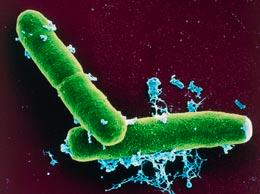The deadly bacterial spores mailed to victims in the US anthrax attacks,scientists say, share a chemical 'fingerprint' that is not found inbacteria from the flask linked to Bruce Ivins, the biodefenceresearcher implicated in the crime.
The Federal Bureau of Investigation (FBI) alleges that Ivins, who committed suicide lastJuly, was the person responsible for mailing letters laden with Bacillus anthracisto news media and congressional offices in 2001, killing five peopleand sickening 17. The FBI used genetic analyses to trace the mailedspores back to a flask called RMR-1029, which Ivins could access in hislaboratory at the US Army Medical Research Institute of InfectiousDiseases (USAMRIID) in Fort Detrick, Maryland.

Investigators used genetic analyses to track down the particular strain of Bacillus anthracis used in the attacks.
At a biodefence meeting on 24 February, Joseph Michael, a materialsscientist at Sandia National Laboratories in Albuquerque, New Mexico,presented analyses of three letters sent to the New York Post and tothe offices of Senators Tom Daschle and Patrick Leahy. Spores from twoof those show a distinct chemical signature that includes silicon,oxygen, iron, and tin; the third letter had silicon, oxygen, iron andpossibly also tin, says Michael. Bacteria from Ivins' RMR-1029 flaskdid not contain any of those four elements.
Two cultures of the same anthrax strain grown using similar processes — one from Ivins'lab, the other from a US Army facility in Utah — showed thesilicon-oxygen signature but did not contain tin or iron. Michaelpresented the analyses at the American Society for Microbiology'sBiodefense and Emerging Diseases Research Meeting in Baltimore,Maryland.
The chemical mismatch doesn't necessarily mean that deadly spores used in the attacks did not originate from Ivins'RMR-1029 flask, says Jason Bannan, a microbiologist and forensicexaminer at the FBI's Chemical Biological Sciences Unit in Quantico,Virginia. The RMR-1029 culture was created in 1997, and the mailedspores could have been taken out of that flask and grown underdifferent conditions, resulting in varying chemical contents. "Itdoesn't surprise me that it would be different," he says.
The data suggest that spores for the three letters were grown using thesame process, says Michael. It is not clear how tin and iron made theirway into the culture, he says. Bannan suggests that the growth mediummay have contained iron and tin may have come from a water source.
Hard to tell apart
The meeting offered scientists who collaborated with the FBI during theinvestigation an opportunity to share detailed data. The analyses willeventually be published in peer-reviewed journals, the FBI has said.
Jacques Ravel, a genomics scientist at the University of Maryland School ofMedicine in Baltimore, described his team's efforts to find geneticdifferences between various cultures of the Ames strain, the B. anthracisstrain identified in the anthrax letters. At first, the team wassurprised to find that the DNA sequences of a reference Ames strain andAmes samples from the investigation, such as bacteria isolated from thespinal fluid of the first victim, were exactly the same. "It was kindof a shock," says Ravel.
For help, the researchers turned to variants found by a team at USAMRIID. Patricia Worsham and hercolleagues had noticed differences in shape, colour and rate of sporeformation even within a single anthrax culture. Ravel's team identifiedthe genetic mutations associated with four variants and developed anassay for one of them, called Morph E. Researchers at CommonwealthBiotechnologies in Richmond, Virginia, and the Midwest ResearchInstitute's Florida Division in Palm Bay created assays for three othervariants.
The FBI then used that arsenal of tests to pin down the origins of the anthrax letters, matching the mix of geneticvariants in the mailed spores to Ivins' RMR-1029 flask. "It has thegenetic signatures that identify it as the most likely source of thegrowth," says Bannan.
Ravel also sequenced the genome of a Bacillus subtilis strain that was found in one of the letters. That sample did not match a B. subtilis strain found in Ivins' lab, says Bannan, but the bacterialcontamination still could have come from somewhere else in Ivins'institution.
The FBI has asked the National Academy of Sciences (NAS) to convene anindependent panel of experts to review the anthrax investigation data.The academy is still in the process of drawing up a contract with theFBI that lays out an agreement to perform the study, says NASspokeswoman Christine Stencel.
Thomas DeGonia, Ivins' lawyer at Venable LLP in Rockville, Maryland, maintains Ivins' innocence.
Comments